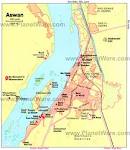Eight centuries after Moses led the Children of Israel from Egypt, a Jewish community thrived on Elephantine Island, a small isle on the Nile in Southern Egypt near the present-day Aswan.
Archaeologists date the origin of the Elephantine community to the dispersion and exile of the Jews from ancient Israel following the destruction of the First Temple in 586 BCE.
Almost everything we know about this interesting chapter of Jewish exilic life comes from the discovery by American Egyptologist Charles Edwin Wilbour in 1893 of a large collection of scrolls, known as the Elephantine papyri, dating back to antiquity. (Eight of these papyri and many related artifacts were on view in 2004 at the Skirball Cultural Centre of Los Angeles in a major exhibition titled “Jewish Life in Ancient Egypt: A Family Archive from the Nile Valley.”)
Five hundred years older than the Dead Sea Scrolls, the papyri provide historical information about marriage, labour conditions, real estate, religion and burial among the Jews of Elephantine in the 5th century BCE. They are a fascinating reflection of the Biblical accounts given in II Kings and Jeremiah that Jews returned to Egypt after the destruction of Solomon’s Temple.
 Having seen the Jerusalem Temple destroyed, the Elephantine Jews built a new Temple in which they burned incense, performed animal sacrifice, and worshipped the God of Abraham. As the papyri indicates, the Jews of Elephantine observed the Sabbath and the Feast of Matzah (Passover) like their modern counterparts. However, they also worshipped secondary gods and borrowed many sacred rituals from their Egyptian and Persian neighbours, with whom they lived in multicultural harmony.
Having seen the Jerusalem Temple destroyed, the Elephantine Jews built a new Temple in which they burned incense, performed animal sacrifice, and worshipped the God of Abraham. As the papyri indicates, the Jews of Elephantine observed the Sabbath and the Feast of Matzah (Passover) like their modern counterparts. However, they also worshipped secondary gods and borrowed many sacred rituals from their Egyptian and Persian neighbours, with whom they lived in multicultural harmony.
Astonishingly well preserved, the papyri are written in Aramaic and belonged to an official of the Temple named Ananiah; they are filled with details about his wife Tamut, an Egyptian slave, and their son and daughter, Palti and Yehoishema. ♦
© 2004








